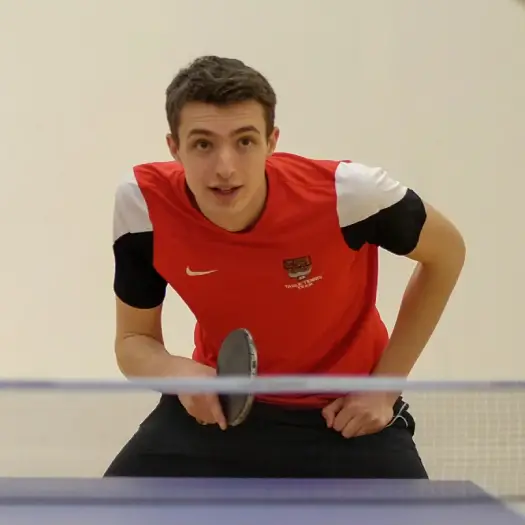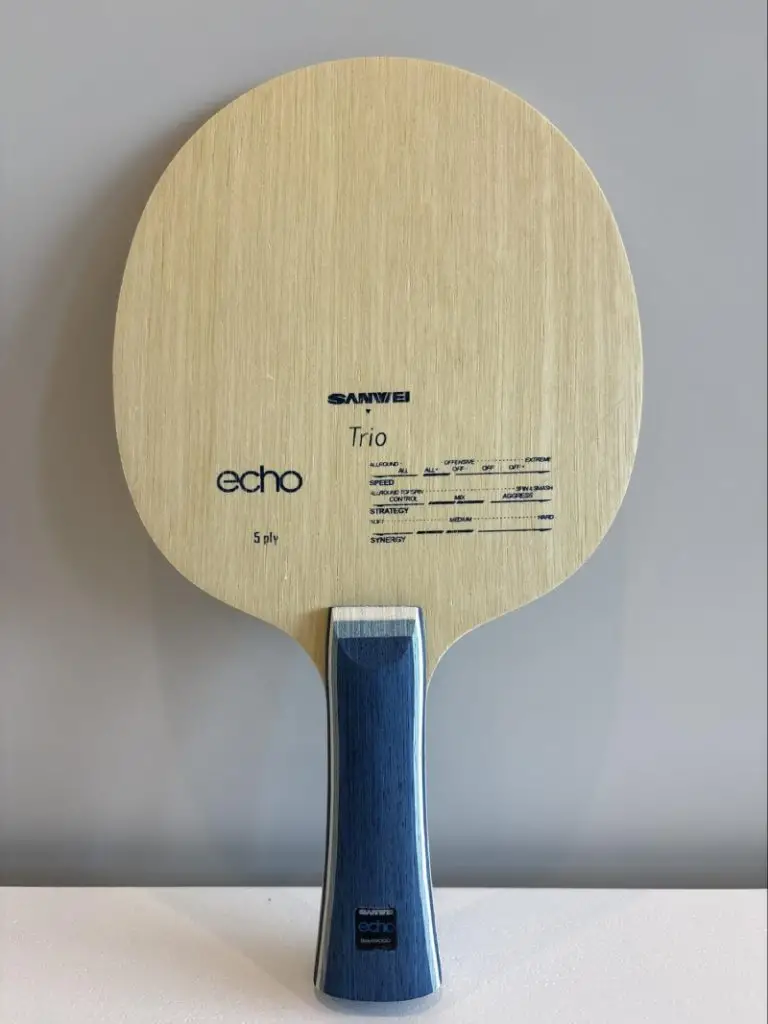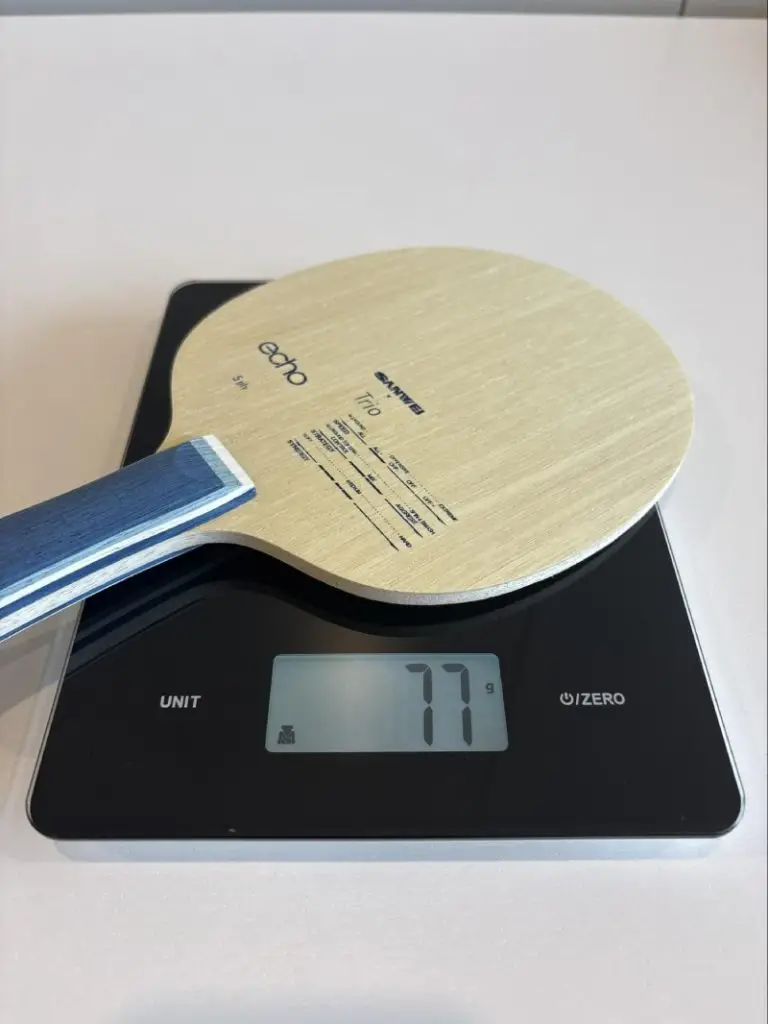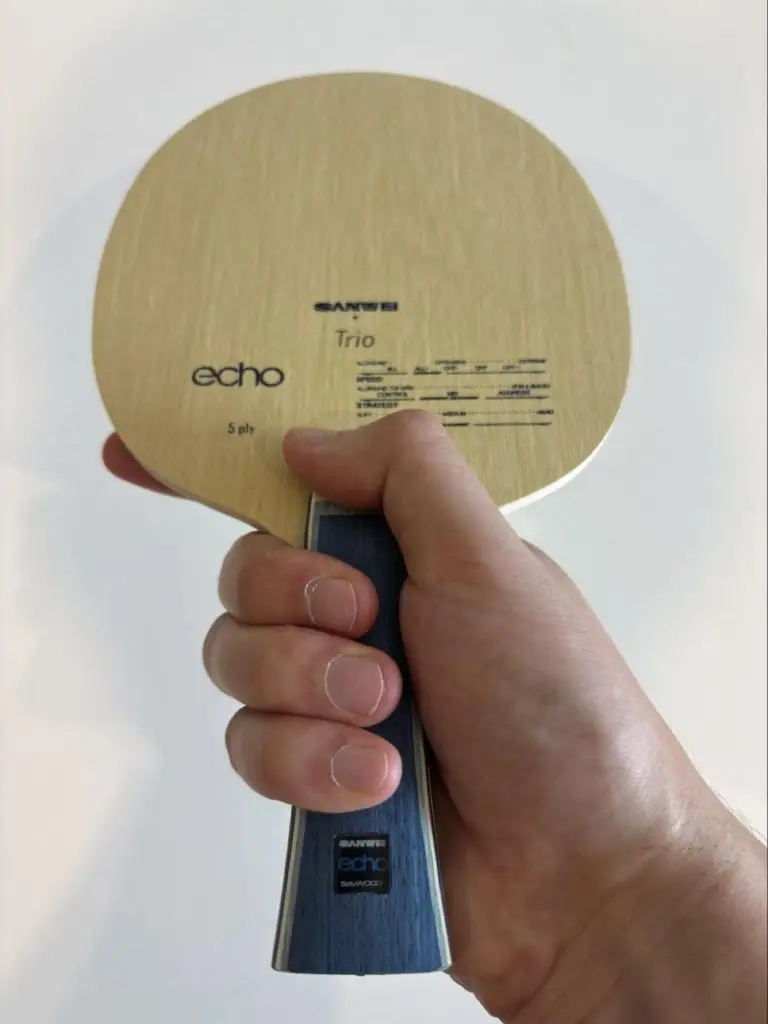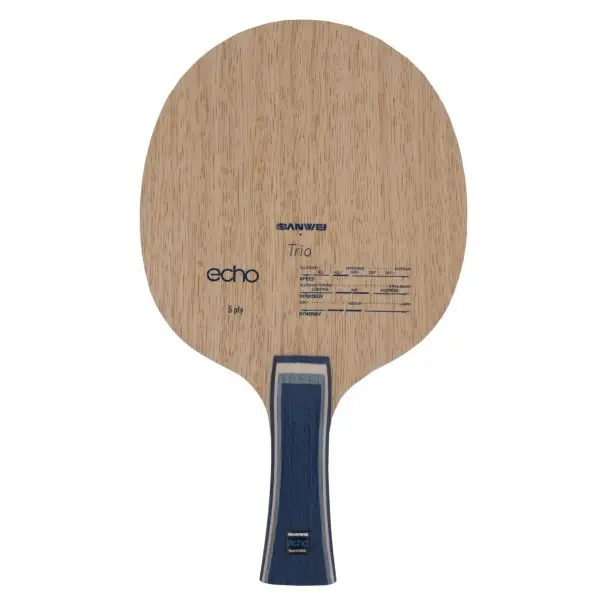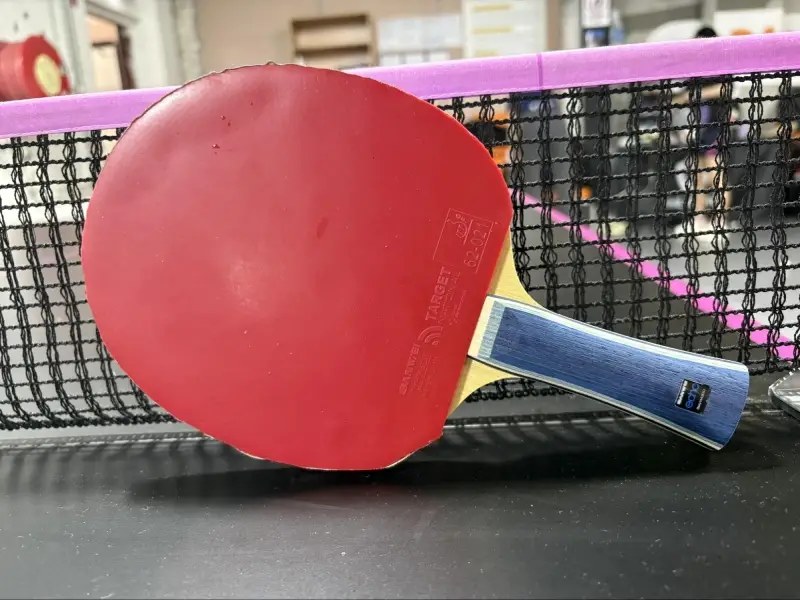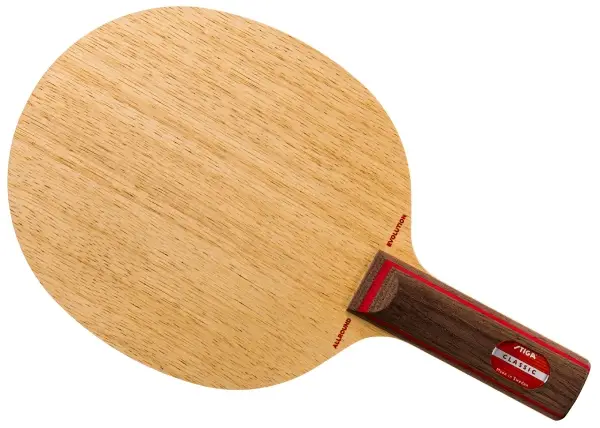Most club points are won with spin and placement, not carbon‑fed power. So, can a $20–30 all-wood blade deliver premium‑grade control and finish?
Sanweiâ€s Echo is an ALL blade that promises linear rebound, safe arcs, and precise touch at budget pricing.
I trained for 15+ hours with the Echo to see if itâ€s up to the task as a great all-round beginners blade.
SANWEI ECHO REVIEW SUMMARY
Sanwei Echo is a 5‑ply limba/ayous ALL/ALL+ control blade with a medium‑soft, linear feel and neutral balance that delivers safe, spinny arcs and precise short‑game touch at a $20–30 price point.
It excels at backhand blocking and placement against strong topspin, confident forehand brush‑openings versus backspin, and stable counterlooping from mid‑distance.
However, flat hits and high‑ball smashes reach their ceiling early, off‑table finishing demands significant acceleration, and anyone chasing crisp, explosive rebound will likely want a stiffer 7‑ply or inner‑carbon option.
Perfect for: Beginner & intermediate club players with 1–5 years experience whose game is built on spin and placement seeking neutral balance, medium‑soft feel, safe brush‑openings vs backspin, and precise backhand blocking.
Benefits
Precise short‑game touch.
Standout blocking and placement.
Safe, spinny arcs for stable counters.
Clear feedback
Generous sweet spot.
Excellent value for $20–30.
Drawbacks
Limited flat‑hit/smash power.
Off‑table finishes need acceleration.
Not for catapult‑seekers.
Less punch on quick counters.
About the Reviewer

David brings 20 years experience as a player, with 10 of those coaching players of all ages and standards. His style is The All-Rounder
About the Review
Forehand Rubber:Sanwei Target National
Backhand Rubber:Sanwei Gear Hyper
Hours Tested:15+
Test Levels:Intermediate to Advanced Training & Matches
Page Contents (Quick Links)
Recommended Playstyles
Spin‑first, placement‑driven players who value short‑game control, safe brush openings, and precise blocking from close to mid‑distance.
Design of the Sanwei Echo
The Echo features a sky-blue handle with clear lens accents and Sanwei’s branding printed cleanly on the blade face.
The finish is smooth and polished, with attention to details like handle accents typically found on blades priced 2-3x higher from Japanese and European manufacturers.

Construction Specifics
The blade uses a 5-ply all-wood construction with limba outer plies and an ayous core flanked by ayous intermediate layers.
Thickness measures approximately 5.9mm. Weight ranges from 75-85g, with most blades landing around 80g. Mine weighed 77g. The head measures 150-155mm.

The limba outer plies provide the characteristic soft feel of all-wood blades whilst the 3.5-3.8mm ayous core adds structural stability.
Handle options include flared, straight, and Chinese penhold.
Value Assessment
At $20-30 USD, the Echo’s construction quality compares to blades priced at $50-60 (Butterfly Primorac, Stiga Allround Evolution).
Both my experience and multiple other reviews Iâ€ve read have noted the finish and material quality match these higher-priced options. Compared to budget alternatives in the $10-20 range (DHS Wind, 729 M8), the Echo offers meaningfully better handle comfort, finish quality, and construction consistency for a modest price increase.

- Construction: 5‑ply all‑wood
- Outer Plies: Limba
- Core: Ayous (~3.5–3.8 mm)
- Thickness: ~5.9 mm
- Head Size: ~150–155 mm
- Weight:80 g +/- 5.0g
- Speed Category: ALL / ALL+
- Handle Types:
- Flared
- Straight
- Chinese Penhold
- Price Range:$20–30 USD
- Stiffness:Medium
- Feel:Medium‑soft with clear feedback
Summary:A 5‑ply limba/ayous ALL/ALL+ control blade with a medium‑soft, linear feel that delivers safe, spinny arcs and precise short‑game touch at a $20–30 price point. An ideal spin‑first, placement‑driven platform from beginner to advanced.
Playtesting Experience
I set up a flared-handle Echo with Sanwei Target National on the forehand and Sanwei Gear Hyper on the backhand.
Total racket weight sat at 180 g and the balance felt neutral with no obvious head‑heaviness. Target Nationalâ€s tacky topsheet amplified dwell and spin on the forehand, while Gear Hyper added a bit of pop on the backhand without compromising the short game.
From the first hits, the blade showed a medium‑high arc on loops that cleared the net safely and dipped with spin. The rebound was linear and predictable, especially in touch play (no surprise catapult). Contact felt clear and medium‑soft with enough dwell to “hold†the ball before release.
I logged 15+ hours across structured drills and club matches against intermediate to advanced players.
I found that comfort came quickly where forehand brush‑and‑lift against backspin felt natural from the start, and backhand blocking settled fast with consistent placement on incoming topspin. The only adjustment was on flat finishes where compared to carbon or stiff 7‑plies, I needed to accelerate more to reach true put‑away pace.
Speed and Control
Speed-wise, the Echo sits in true ALL/ALL+ territory. Compared to a typical blade like Stiga Allround Evolution, itâ€s a hair livelier with my Target National (FH) + Gear Hyper (BH) setup.
Power delivery is linear rather than explosive. If you accelerate, it gives you pace; if you soften the hand, it stays calm.
In the short game, control is the defining trait. Serves, drops, and touch receives stay low without unexpected bounce. Flicks and banana receives are predictable so you feel the ball, set the angle, and it goes where you aim.
On drives and counter‑hitting, the forehand needs very quick acceleration to finish points. I found that counterlooping from mid‑distance is stable with a medium‑high arc.
Blocking is a standout. Against stronger topspin, the Echo absorbs pace and gives precise directional control. Itâ€s very easy to take the pace off and place wide corners or into the elbow. The sweet spot feels generous for an all‑wood 5‑ply wehre off‑center contacts still deliver usable feedback and trajectory.
On the downside, flat drives and high‑ball smashes top out much earlier than 7‑ply OFF blades (e.g., Sanwei Parla). Off‑the‑table power depends more on your swing than blade rebound so if your game leans on finishing through pace rather than spin/placement, youâ€ll need to work harder for outright winners.

Feel
The Echo communicates cleanly without being harsh. Contact feels medium‑soft thanks to the limba outers, and feedback is crisp enough that you know exactly how much you brushed or drove the ball.
With Target National on the forehand, I found thereâ€s an obvious dwell where the ball compresses, the topsheet grabs, then the blade releases in a calm, linear way.
Vibration damping sits around medium, where you feel useful information through the handle without any sting on off‑center hits.
The sweet spot is generous for a 5‑ply all‑wood. Even slightly mis‑timed blocks hold a stable trajectory rather than squirting off. In rallies, that translates into confidence where you can vary spin without the blade surprising you.
Ergonomically, my flared handle sample was comfortable and well‑finished, with a neutral balance. I had no fatigue across longer sessions.
Value
The Echo delivers above its price point. At $20–30 USD, you get genuine ALL/ALL+ performance, a clean finish, and construction that competes with mid‑tier classics.
Within its price tier, cheaper options like DHS Wind and 729 M8 save a few dollars but compromise on handle comfort, finish, and liveliness.
Stepping up, the Echo sits alongside $50–60 blades such as Butterfly Primorac OFF‑ and Stiga Allround Evolution. Itâ€s a touch slower than Primorac and similar in control to Allround Evolution, yet costs roughly half.
In short, if you prioritize consistency and spin with enough speed when you commit to the shot, the Echo is one of the strongest value plays in the all‑wood all‑round category.
Alternatives To The Sanwei Echo

Stiga Allround Evolution
A control‑first 5‑ply thatâ€s a touch faster and a bit stiffer than the Echo with less dwell, but costs roughly 2–3× as much.

Butterfly Primorac OFF‑
Offers more outright speed and flatter hit punch than the Echo, while the Echo gives softer feel, higher dwell, and better short‑game control.

Sanwei Parla (7‑ply)
The Echoâ€s faster 7‑ply sibling: noticeably more pace and a crisper hit for aggressive looping, with slightly lower dwell and forgiveness, at a modest price bump.
Overall Reflections
The Echo is a true ALL/ALL+ 5‑ply control blade. Linear, predictable, and easy to trust.
Its defining strength is feel and placement where youâ€ll get medium‑soft contact, clear feedback, and a safe, medium‑high arc that rewards spin‑first strokes.
This blade is perfect for developing players and club‑level all‑rounders who value consistency, short‑game touch, and confidence in opening against backspin. Advanced players with a control/spin bias will also appreciate it as a stable platform that pairs well with faster rubbers.
However, itâ€s important to keep in mind that flat drives and high‑ball smashes reach their ceiling much sooner than stiffer 7‑plies or inner‑carbon OFF blades. Off‑the‑table power depends heavily on having power on your swing which often results in a loss of accuracy for beginners.
At $20–30 USD, the Sanwei Echo overdelivers.
If your game is built on spin, placement, and reliable touch, and youâ€re willing to supply the acceleration for finishes, the Echo is an easy recommendation and one of the best buys in the all‑wood all‑round category.
![]()
David’s been playing Table Tennis since he was 12, earning his first coaching license in 2012. He’s played in national team & individual competitions, although he prefers the more relaxed nature of a local league match! After earning his umpiring qualification in England, David moved to Australia and started Racket Insight to share information about the sport he loves.
Blade: Stiga WRB Offensive Classic | Forehand: Calibra LT | Backhand: Xiom Musa
Playstyle: The All-Rounder
Discover more from 6up.net
Subscribe to get the latest posts sent to your email.
